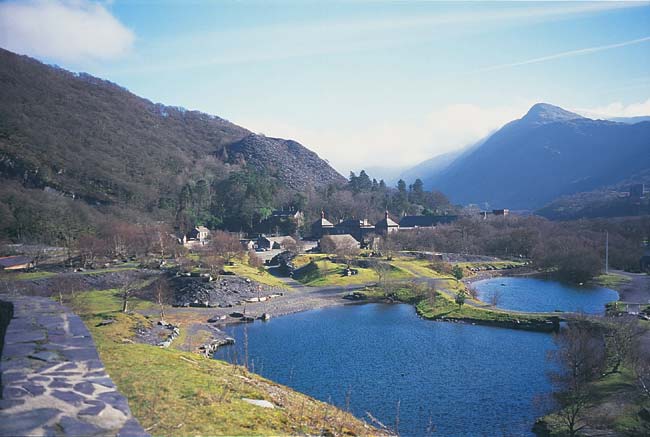
My WILLIAMS Family History by William Hartley
Thomas Williams b.1810 Northenden ... All references: William Hartley author http://www.hartleyfamily.uk

Llanberis Slate,Caernarfonshire, North Wales
I
can confidently trace my WILLIAMS family to Thomas WILLIAMS, born at
Northenden, Cheshire in 1810. Thomas married Sarah LEIGH, who came
from an aristocratic family with a rich history in Cheshire. They married in
1834 at Manchester Cathedral.
Thomas' parents were Thomas WILLIAMS and Margaret CARRINGTON, who married
at Manchester Cathedral in 1807. Thomas was aged 24, and had been born at Ysgubor
Newydd Farm near Llandwrog, Caernarvonshire. His father James had also married
aged 24, in 1784, his wife was Jane. I think James had been baptised in 1760
at Conwy, along the north coast, so he may have had family there. I believe
the Williams surname came from William Williams, Sheriff of Caernarvonshire,
of 1429-1500 who built the first Vynol Hall.
 Ysgubor Newydd Farm, Llandwrog,
Caernarvonshire
Ysgubor Newydd Farm, Llandwrog,
Caernarvonshire
My research suggests my WILLIAMS family had deep roots in Caernarvonshire, and were likely descended from the aristocratic WILLIAMS family from Cochwillan, Penrhyn, Varnol. That family was descended from ancient Britons who later formed the Tudor royal line. The Tudor and Williams lines had links to the GRUFFORD family, and are well documented. Grufford Williams was Lordc of Nant, and had died in 1405 during the Owen Glendower uprising. Earlier aYsncestors included Cadell, King of the Britons.
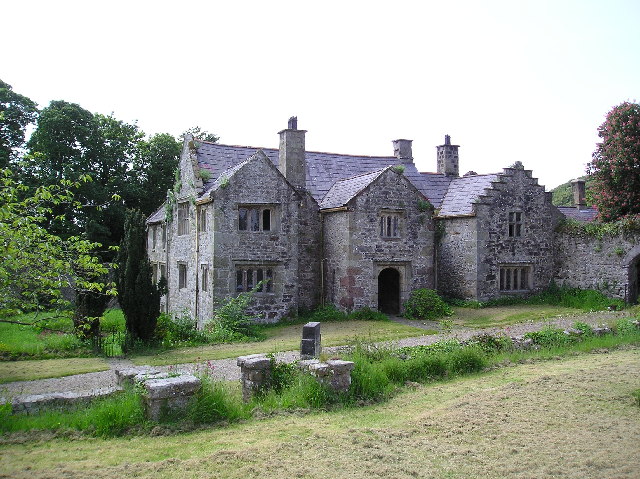 Vaynol Old Hall
Vaynol Old Hall 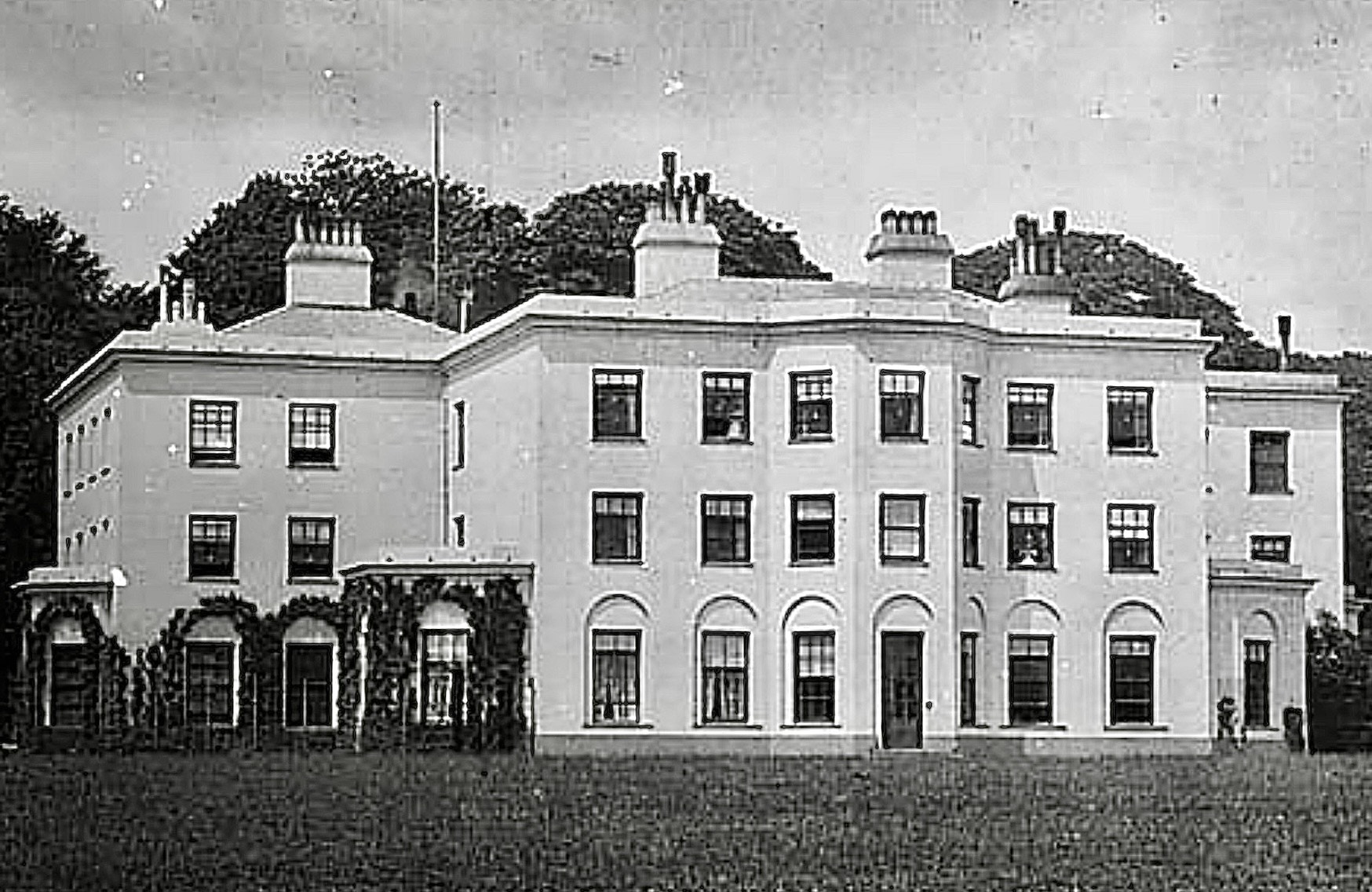 Vaynol
House : see
Vaynol [Y Faenol]
Vaynol
House : see
Vaynol [Y Faenol]
Thomas and Sarah's family men were Slaters and Tilers [Roofers] and later Slate Merchants in Lincolnshire, where they had homes named 'Llanberis' and 'Bangor', confirming their origins in Caernarvonshire. The family went from being Farmers at Llandwrog, to being Slaters and Roofers at Llanberis, then Cheshire, Manchester and Oldham, and finally at Lincoln, Leicester and Coventry.
There
is also a family story that the Williams family "came to Lincoln by walking
from North Wales" [Rosemary Jackson]
I take this story literally, that they walked alongside wagons
loaded with blocks of slate, from Llanberis to Lincoln via the turnpike roads.
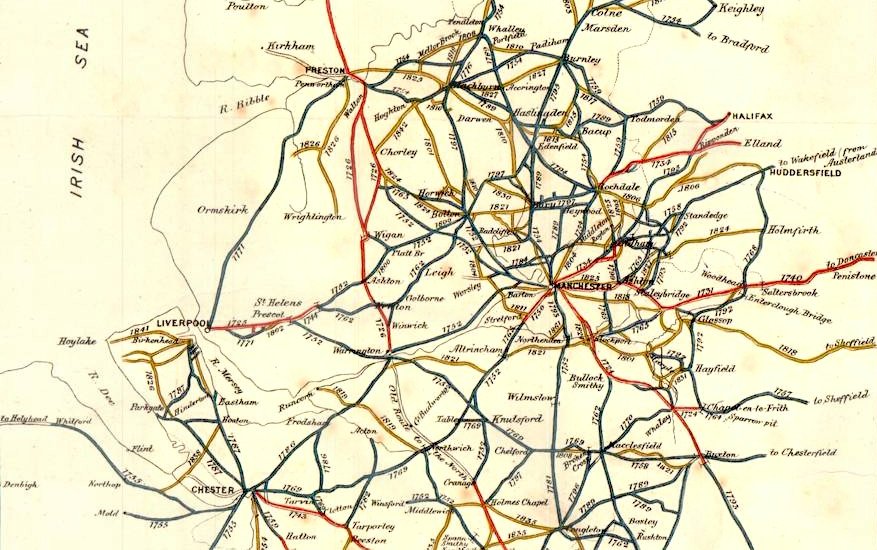 This
map shows the turnpike road network built in the 18thC and 19thC. The road from
North Wales to Altrincham via Chester was in place by 1769. But why did our
Williams family leave North Wales?
This
map shows the turnpike road network built in the 18thC and 19thC. The road from
North Wales to Altrincham via Chester was in place by 1769. But why did our
Williams family leave North Wales?
 At Llanberis, local people had been working the mountains for thousands of years,
extracting slate from lots of small open quarries.The large landowners were
initially content to issue "take notes", allowing individuals to quarry slates
on their lands for a yearly rent of a few shillings and a royalty on the slates
produced.
At Llanberis, local people had been working the mountains for thousands of years,
extracting slate from lots of small open quarries.The large landowners were
initially content to issue "take notes", allowing individuals to quarry slates
on their lands for a yearly rent of a few shillings and a royalty on the slates
produced.
It was with the dawn of the Industrial Revolution in the 18thC that the slate
industry really took off. As small villages such as Manchester exploded into
large towns and then cities with the coming of mills and factories, there was
an enormous demand for slates to roof the long terraces of houses built as homes
for the workers – as well as the factories, foundries, mills and warehouses
themselves.
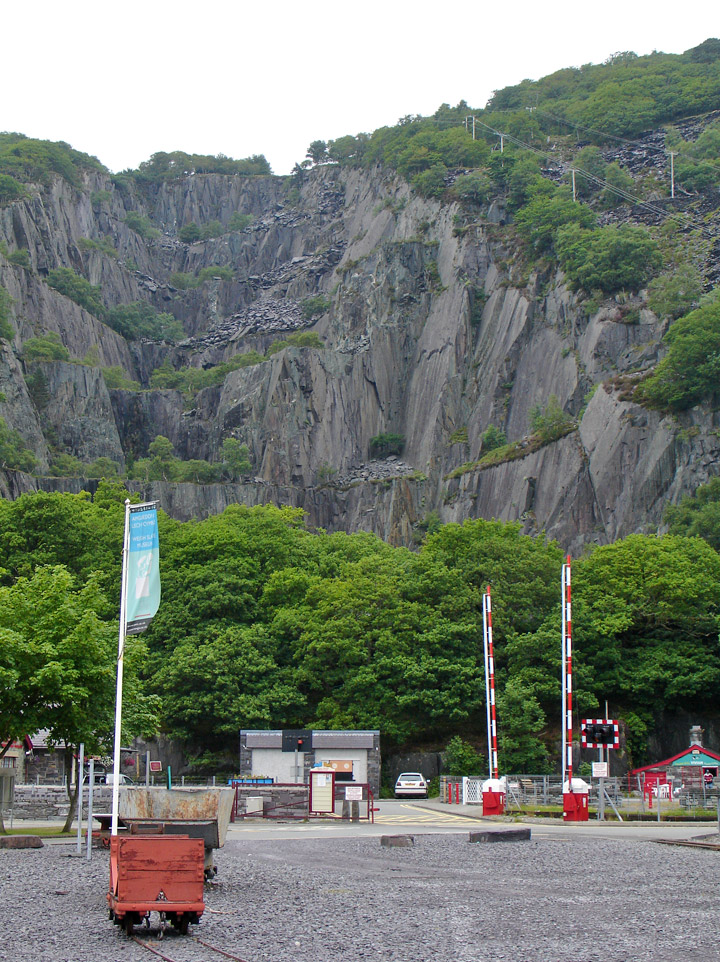 In 1787 the ‘Great New Quarry’ of Dinorwig
was opened by a partnership of three businessmen – one of them Thomas Assheton
Smith – on the slopes between the present village of Dinorwig and Llyn Peris.
In 1788, the Assheton-Smith family [who came from Ashley Hall, Cheshire] took
over the entire area and paid bailiffs to evict local people out of their quarries.
In 1787 the ‘Great New Quarry’ of Dinorwig
was opened by a partnership of three businessmen – one of them Thomas Assheton
Smith – on the slopes between the present village of Dinorwig and Llyn Peris.
In 1788, the Assheton-Smith family [who came from Ashley Hall, Cheshire] took
over the entire area and paid bailiffs to evict local people out of their quarries.
 Their estate, Vaynol [Y Faenol]
on
the banks of the Menai Straits, covered 34,000 acres of land. In George William
Duff Assheton-Smith's time, white cattle, deer and American bison — not to mention
bears and monkeys — roamed Vaynol Park. The Vaynol Estate developed from the
Crown manor of Dinorwig, and was leased in the sixteenth century to a member
of the Cochwillan. By the death of Sir William Williams in 1696, and he being
childless, he ceded the whole estate to the Crown! Sometime before 1723, the
Crown granted the reversion of the estate to John Smith, of Tedworth, Hampshire.
His family taking possession in 1756. Eight years later, William Smith left
Tedworth and Faenol to his nephew, Thomas Assheton of Ashley Hall, Cheshire,
who took the name Smith in 1774.
Their estate, Vaynol [Y Faenol]
on
the banks of the Menai Straits, covered 34,000 acres of land. In George William
Duff Assheton-Smith's time, white cattle, deer and American bison — not to mention
bears and monkeys — roamed Vaynol Park. The Vaynol Estate developed from the
Crown manor of Dinorwig, and was leased in the sixteenth century to a member
of the Cochwillan. By the death of Sir William Williams in 1696, and he being
childless, he ceded the whole estate to the Crown! Sometime before 1723, the
Crown granted the reversion of the estate to John Smith, of Tedworth, Hampshire.
His family taking possession in 1756. Eight years later, William Smith left
Tedworth and Faenol to his nephew, Thomas Assheton of Ashley Hall, Cheshire,
who took the name Smith in 1774.
 Although many of the families in
the villages around Llanberis kept smallholdings and fattened a pig or a calf,
the whole area depended for its livelihood on the slate industry. In 1809 the
landowner, Thomas Assheton-Smith of Vaynol, Bangor, took the management of the
quarry into his own hands.
Although many of the families in
the villages around Llanberis kept smallholdings and fattened a pig or a calf,
the whole area depended for its livelihood on the slate industry. In 1809 the
landowner, Thomas Assheton-Smith of Vaynol, Bangor, took the management of the
quarry into his own hands.
I'm pretty certain my WILLIAMS family left Llanberis for Cheshire around the time the Assheton-Smith family took over the estates in North Wales.
Thomas born in 1810 in Cheshire would have likely been the first son of Thomas
and Margaret.
Since the Assheton-Smith family came from Ashley Hall, Cheshire, I believe my
WILLIAMS family moved from North Wales to the Altrincham area south of Manchester,
near or within the Ashley Hall Estate, by about 1805. They were skilled slaters
and were much needed to roof the thousands of buildings going up, in and around
Manchester, in the early19thC.
 Returning to the turnpike roads network map above, I believe that the Williams
family moved to the Altrincham area in the late 18thC to early 19thC to provide
slate roofs for the growing demand in the Manchester area. However, at that
time, the turnpike roads to the east of England were incomplete. It wasn't until
1821 that the road between Altrincham and Stockport was constructed, thereby
allowing speedier transport between North Wales and the East of England and
Lincoln. I believe that when Thomas WILLIAMS reached adulthood in the 1830's,
he decided to branch out on his own, firstly moving from Northenden to Oldham,
then on to Lincoln in the 1840's. It would have been feasible for him to have
transported blocks of slate from North Wales to Lincoln via the turnpike roads
in about ten days. Once the blocks reached Lincoln, he could have split the
blocks into roof slates, thereby limiting damage to the slate. Having a good
supply of slate from North Wales, and premises allowing him to split the blocks
of slate, he would have had good reason to establish a Slate Merchants business
at Lincoln.
Returning to the turnpike roads network map above, I believe that the Williams
family moved to the Altrincham area in the late 18thC to early 19thC to provide
slate roofs for the growing demand in the Manchester area. However, at that
time, the turnpike roads to the east of England were incomplete. It wasn't until
1821 that the road between Altrincham and Stockport was constructed, thereby
allowing speedier transport between North Wales and the East of England and
Lincoln. I believe that when Thomas WILLIAMS reached adulthood in the 1830's,
he decided to branch out on his own, firstly moving from Northenden to Oldham,
then on to Lincoln in the 1840's. It would have been feasible for him to have
transported blocks of slate from North Wales to Lincoln via the turnpike roads
in about ten days. Once the blocks reached Lincoln, he could have split the
blocks into roof slates, thereby limiting damage to the slate. Having a good
supply of slate from North Wales, and premises allowing him to split the blocks
of slate, he would have had good reason to establish a Slate Merchants business
at Lincoln.
Thomas of 1810 married Sarah LEIGH ... I believe she was distantly related to the LEIGH/LEGHs of Cheshire and Lancashire and that my WILLIAMS were similarly distantly related to the WILLIAMS family of Vaynol, Bangor. The Asshetons took over the Williams' Estates at Vaylor, Bangor. [click on links]
to be continued ...
William Hartley 2024
william@hartleyfamily.uk
All references: William Hartley author http://www.hartleyfamily.uk
 What is Slate? Slate is essentially mud that has first been compressed and compacted,
and then squeezed and heated by the Earth’s forces. Dinorwig Quarry slates originated
as mud deposited in the sea during the Cambrian era of the Lower Paleozoic Age.
Movement of tectonic plates formed the mountains of Wales, and provided the
pressure to change this mud into slate. The high quality of the slates is a
result of the purity of the original mud and sufficient pressure and heat. Sericite
mica, quartz, chlorite, haematite and rutile – these minerals are the main components
of slate. Tiny variations in the proportion of some of these minerals can lead
to a rainbow of variations in the colours of the slates themselves – from different
shades of green through grey and blue to a deep, rich red. Nine layers of slate
run through Elidir mountain and they bear such lovely names as: green and wrinkled,
redwood, red, old quarry blue, new quarry blue grey, new quarry blue grey mottled,
sage green, willow green, bronze, and purple red.
What is Slate? Slate is essentially mud that has first been compressed and compacted,
and then squeezed and heated by the Earth’s forces. Dinorwig Quarry slates originated
as mud deposited in the sea during the Cambrian era of the Lower Paleozoic Age.
Movement of tectonic plates formed the mountains of Wales, and provided the
pressure to change this mud into slate. The high quality of the slates is a
result of the purity of the original mud and sufficient pressure and heat. Sericite
mica, quartz, chlorite, haematite and rutile – these minerals are the main components
of slate. Tiny variations in the proportion of some of these minerals can lead
to a rainbow of variations in the colours of the slates themselves – from different
shades of green through grey and blue to a deep, rich red. Nine layers of slate
run through Elidir mountain and they bear such lovely names as: green and wrinkled,
redwood, red, old quarry blue, new quarry blue grey, new quarry blue grey mottled,
sage green, willow green, bronze, and purple red.
 Quarrying Slate Dinorwig Quarry was carved out of the mountain itself – Elidir
Mountain, high above Gilfach Ddu. The first step in the process of quarrying
slate was to free a piece of rock – which might weigh hundreds of tons – from
the face. The quarrymen would drill into the rock and fill it with powdwr du
[‘black powder’] or explosive. One man would place a fuse in the powder and
fire it before running to join his workmates in the blast shelter. The blasting
happened at particular times of day. After returning to the rock face the men
would need to clear the rubble and any precarious sections of rock. Two quarrymen
would then turn the slate block into 'pillars' of 100kg–200kg each with a cold
chisel and a hammer. Another two members of the team would be working in one
of the open sheds. Having pillared the blocks into rectangular slabs, one of
the men would then split them to different thicknesses, depending on the quality
of the rock. Using a wide-bladed splitting chisel and a mallet of African oak
he would aim to get 16 slates from the one piece – depending on the quality.
Quarrying Slate Dinorwig Quarry was carved out of the mountain itself – Elidir
Mountain, high above Gilfach Ddu. The first step in the process of quarrying
slate was to free a piece of rock – which might weigh hundreds of tons – from
the face. The quarrymen would drill into the rock and fill it with powdwr du
[‘black powder’] or explosive. One man would place a fuse in the powder and
fire it before running to join his workmates in the blast shelter. The blasting
happened at particular times of day. After returning to the rock face the men
would need to clear the rubble and any precarious sections of rock. Two quarrymen
would then turn the slate block into 'pillars' of 100kg–200kg each with a cold
chisel and a hammer. Another two members of the team would be working in one
of the open sheds. Having pillared the blocks into rectangular slabs, one of
the men would then split them to different thicknesses, depending on the quality
of the rock. Using a wide-bladed splitting chisel and a mallet of African oak
he would aim to get 16 slates from the one piece – depending on the quality.
In the meantime his partner would sit on a 'traval', a straight edge of iron
and steel in a sloping piece of wood. He would trim the slate into a right angle
with a guillotine knife, and then dress it to a particular size. This would
all happen very quickly, almost withouth pause to draw breath, but although
it might look effortless it called for a very keen eye and a sound understanding
of the nature of the rock
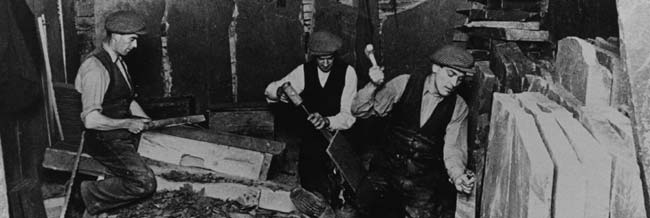
Slate Splitting and Dressing It was in the quarry itself, in the gwalia — the open-sided sheds — that splitting and dressing was actually done; it was later carried out in the yard. The power from the water wheel drove cutting tables by means of the line shafting. Slate sawing was a heavy, dusty and noisy task. A trough of water under the table cooled the wheel as it cut through the slab of slate, and dampen down some of the dust produced. When a hundred or more tables were at work at the same time, there would be so much dust in the air that the other end of the shed would be invisible.
Health problems. The effects of this dust were very damaging to the quarrymen's health, leading to chest diseases, especially tuberculosis and silicosis. The men and their families were given practical hints on healthy living: their houses should be well aired, they should wear flannel next to the skin and wash frequently. The quarryman should 'live for something beyond tea and bread-and butter, and vary his diet with foodstuffs of all kind, particularly garden vegetables'. His injunction to 'Remember there is No Nourishment in Tea' is revealing, as for many years doctors had been blaming silicosis on the men's habit of drinking tea, strong as tar from being on the brew all day.
Names given to Slates. The slates were called by different names according to their sizes — and highly select names they were, too, varying from the 'Ladies' [16 inches by 12 inches] through 'Countesses' [20 inches by 12] and up through the 'Duchesses' and 'Princesses' to the 'Queens', which were 42 inches by 27. Odd though, that men who are said to have spoken only Welsh gave the slates very English names !
The Snowdon Mountain Railway at Llanberis.
Llanberis
itself is quite a new village. Nant
Peris was established first. St Peris church goes back to the 12thC. Llanberis
only developed 200 years ago [late 18thC] with the slate industry.
Dolbadarn
Castle [the Duff family] is the oldest building at Llanberis. There aren't
any older buildings in the village.
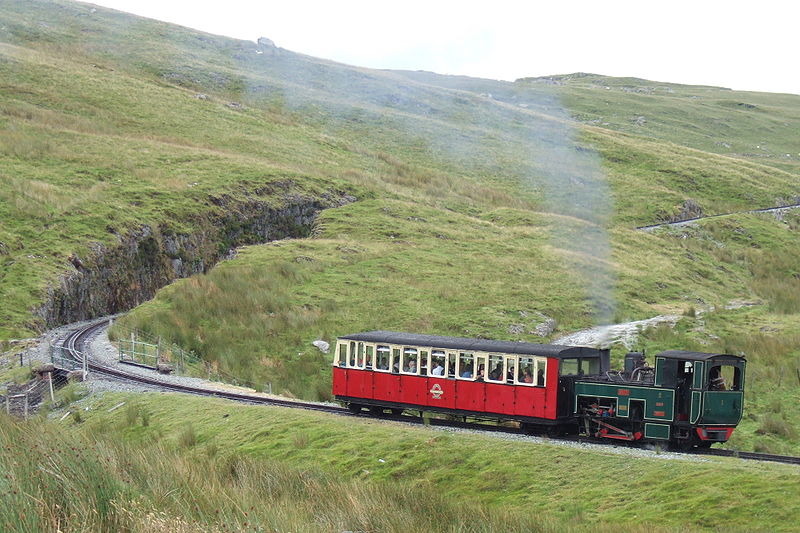 Then the
little mountain railway came to Snowdon. Lord George William Duff Assheton-Smith
of the Vaynol Estate owned the land around Llanberis and Dinorwig Slate Quarry.
In the 1860s he holidayed at Lucerne, Switzerland, and went up the Rigi Mountain
on a little Swiss mountain train. It was there he had the idea of installing
a rack and pinion railway to run up Mount Snowdon. The original idea was to
have a railway from Llanberis to the top of the mountain and from Llanberis
to Rhyd Ddu. The trains were made in Winterthur, Switzerland. Lord Assheton-Smith
bought five and shipped then all the way to Llanberis. The track was layed in
just 72 days by three hundred workers. They also built two viaducts and five
bridges en-route. The train was opened for tourists by Lord Assheton-Smith's
daughter in April 1896. Then, it only used to go up six or seven times a day
but now it is so popular it runs all day long and has to turn away dozens of
people every day.
Then the
little mountain railway came to Snowdon. Lord George William Duff Assheton-Smith
of the Vaynol Estate owned the land around Llanberis and Dinorwig Slate Quarry.
In the 1860s he holidayed at Lucerne, Switzerland, and went up the Rigi Mountain
on a little Swiss mountain train. It was there he had the idea of installing
a rack and pinion railway to run up Mount Snowdon. The original idea was to
have a railway from Llanberis to the top of the mountain and from Llanberis
to Rhyd Ddu. The trains were made in Winterthur, Switzerland. Lord Assheton-Smith
bought five and shipped then all the way to Llanberis. The track was layed in
just 72 days by three hundred workers. They also built two viaducts and five
bridges en-route. The train was opened for tourists by Lord Assheton-Smith's
daughter in April 1896. Then, it only used to go up six or seven times a day
but now it is so popular it runs all day long and has to turn away dozens of
people every day.
All references: William Hartley author http://www.hartleyfamily.uk
My
Paternal Grandfather John William HARTLEY's Family
Tree 
Index to Names
Index to Surnames
My Home Page
My Paternal Great Uncle ![]() Nathaniel HARTLEY
Nathaniel HARTLEY
My Father ![]() Mac HARTLEY
Mac HARTLEY
My
Mother ![]() Joyce WILLIAMS
Joyce WILLIAMS
My
WILLIAMS Family
My Maternal Grandfather ![]() Henry Llech WILLIAMS
Henry Llech WILLIAMS
please
bookmark this website address: www.hartleyfamily.uk
![]()
e-mail enquiries to: enquiries@hartleyfamily.uk
All references: William Hartley author http://www.hartleyfamily.uk
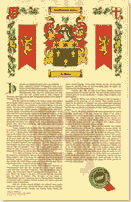 HARTLEY
Crest and Coat of Arms
HARTLEY
Crest and Coat of Arms ![]() Shop
Shop
Shop at  for HARTLEY gifts; plaques, tiles, framed crests, t-shirts etc.
for HARTLEY gifts; plaques, tiles, framed crests, t-shirts etc.
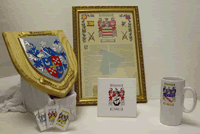 Special Exclusive Discounts for HARTLEY Reunions. Click on pic to left, then
enter HARTLEY in search, then click on 'Family Reunions' under the 'Products'
heading. Generous savings available through www.hartleyfamily.org.uk
Special Exclusive Discounts for HARTLEY Reunions. Click on pic to left, then
enter HARTLEY in search, then click on 'Family Reunions' under the 'Products'
heading. Generous savings available through www.hartleyfamily.org.uk